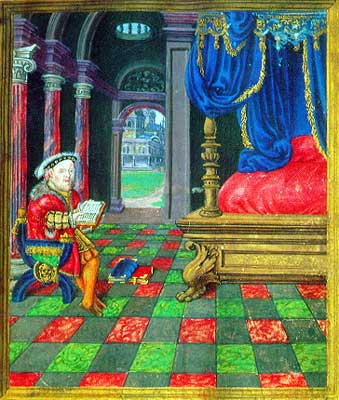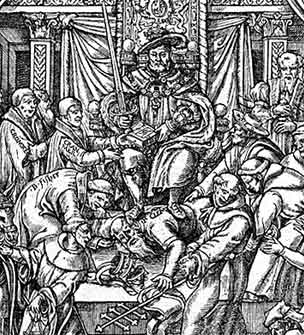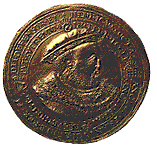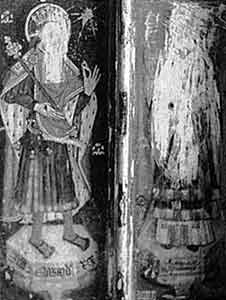|
|
|
|
|
|
|
|
|
|
|
|
|
|
|
|
|
|
|
|
|
|
|
|
|
|
|
|
|
|
|
 |
|
|
|
|
|
|
|
|
|
|
|
|
|
|
|
|
|
|
|
|
|
|
|
|
 |
|
|
|
|
|
|
 |
|
|
|
|
While
the word of God was used as the basis for Henry
VIII's assumption as Head of the Church of
England, it was also utilized as an example of the paramount duty of obedience
that loyal subjects owed their king. This call for obedience was a central theme
to the propaganda of the Henrician Reformation. In order to facilitate devotion
to his position over the pope, Henry was inspired by divine law as illustrated
in the Old Testament and perfect obedience to it as seen in the life and teachings
of Christ in the New Testament. True obedience is obeying the divinely instituted
authorities, supreme of which are kings, who are considered to be in God's image
and his vicars on earth. Therefore the authority of the church and scriptures
is placed within the realm of the king and not the pope. To define his supremacy
Henry VIII looked to the Biblical sovereignty of David and Solomon and their
jurisdiction over the priests of the temple, while he also began iconographically
appearing in the guise of these biblical characters, most notably that of Josiah
as abolisher of idols. |
|
|
|
|
|
|
|
|
|
|
|
|
|
Henry
VIII depicted as the Biblical King David reading books from Henry VIII's
Psalter, c. 1530-33. |
|
|
|
|
|
|
|
|
 |
|
|
|
|
|
|
|
|
|
|
|
|
|
|
|
|
|
|
|
|
|
|
|
|
|
|
|
|
It
was at this time that Henry VIII began to work on images that would enhance
his royal iconography and create a cult of monarchy that sought to visually
reflect the king's sacred authority. The invocation of biblical kings confirmed
his power within the realm, while also fulfilling the divine role as head of
the Church of England that he cast himself in. |
|
|
|
|
|
|
|
|
|
|
|
|
|
|
Henry
VIII was the first English king to appropriate the Renaissance fashion of issuing
coinage displaying his image. Henry wished to turn his reign into a time of
sacred and theocratic kingship and instituted this sacralization by reinstating
the tradition of touching for the king's evil and calling for the canonization
of his forbearer Henry VI . By instituting sacred kingship, the monarchy hoped
to achieve new levels of respect and awe for the divine rule of kings. |
|
|
|
|
|
|
|
|
|
|
|
|
|
|
|
|
|
|
|
|
|
 |
|
|
|
|
|
|
|
|
|
|
|
|
|
Coin
depicting Henry VIII as Supreme Head of the Church of England |
|
|
|
|
|
|
|
Allegory
of the Reformation. Detail of Pope Clement supressed
by Henry VIII. |
|
|
|
|
|
|
|
|
|
|
|
Another
form of propaganda available to the realm was the rewriting of English history
for the purpose of breaking with Rome and the papacy, while establishing the
independence of the English church. Greater emphasis was placed on the legendary
accounts of the origins of British Christianity over the evangelisation began
by St. Augustine at the behest of Pope Gregory I. Revisionist such as John Bale,
went as far as to write that British Christianity had its origins in the mythical
arrival of Joseph of Arimathea in order to reduce any hint of papal intervention.
This revisionist fervor was taken a step further in the new accounts ascribed
to royal figures. The image of English kingship underwent immense alterations
during the 1530's. Under this revisionist history, King John became an unfortunate
patriot persecuted by an oppressive and an interfering Pope Innocent. Famous
stories were modified and the role of saints downplayed. Henry II was no longer
portrayed as a tyrant, and Thomas Becket was proclaimed a traitor with all mention
of his martyrdom and sainthood erased. After 1530 books containing traditional
English history ceased to be published or were adapted to this new way of thinking. |
|
|
|
|
|
|
|
|
|
|
|
|
|
|
|
|
|
|
|
|
|
|
|
|
|
|
|
|
|
|
|
|
|
|
|
|
 |
|
|
|
|
|
|
|
|
|
|
|
|
 |
|
|
|
|
|
|
|
|
|
|
|
|
|
|
The attack on the images
of St. Thomas Beckett was ordered in November of 1538. This defaced representation
of Becket is from a screen at Burlington St. Andrew, Norfolk, which had
only been completed in the mid 1530's. |
|
|
|
|
|
|
|
|
|
|
|
|
|
|
|
 |
 |
 |
 |
 |
 |
 |
 |
 |
 |
 |
 |
 |
 |
 |
 |
 |
 |
 |
 |
 |
 |
 |
 |
 |
 |
 |
 |
 |






